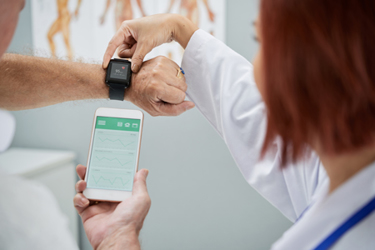DiMe Reports Significant Growth In Digital Endpoints

By Ed Miseta, Chief Editor, Clinical Leader

In October 2019, the Digital Medicine Society (DiMe) launched its crowdsource library of digital endpoints. The library is an open resource that anyone can access. Jennifer Goldsack, CEO of DiMe, is thrilled with the growth the organization has seen thus far.
“When we launched the library, it had 34 unique endpoints from 12 sponsors that were using digital endpoints to answer questions about new medical products,” says Goldsack. “Let me be clear about what the endpoints library covers. It is not proof of concept and it's not exploratory. It only reports on endpoints being used to answer questions about new medical products.”
The library has seen significant growth since then. By September 2021 it had 225 unique endpoints from 69 sponsor companies. The endpoints are now being deployed in industry-sponsored trials. Goldsack notes a significant number of those endpoints are now positioned as primary endpoints in drug trials, and DiMe has seen an increase in the number being used in Phase 2 and Phase 3 studies.
“I believe that says a lot about the trust that sponsors have in these endpoints from both a value point of view and in the clinical science that underlies them,” she says.
A Unique Set Of Endpoints

“I don't think for a moment that there's one perfect measure of sleep or one perfect measure of physical activity,” she says. “These endpoints were selected, developed, and deployed without any sort of conversation between the companies using them. That does begin to raise questions about how long it will take to determine the variability of all of those measures across patients, what is clinically important across those measures, and what do the typical readings look like over the natural history of a disease.”
According to Goldsack, it will take time for the industry to build a body of evidence that will answer those questions. However, she believes it can be rapidly accelerated by cooperation between companies. She believes it is unethical for every company to continue to develop endpoints their own way.
Collaboration Will Lead To Innovation
The large number of digital endpoints and the lack of discussion between the companies developing them has Goldsack excited about a recently announced collaboration. In October, DiMe announced a pre-competitive collaboration with AbbVie, Janssen, Novartis, Pfizer, and UCB. The collaboration is to advance nocturnal scratch as a digital endpoint for atopic dermatitis.
“These are five large organizations,” says Goldsack. “Four of them came to us and one of them came from within our membership. Each company has its own pipeline of products that will compete with each other, but they were willing to come together to develop these tools for patients in the pre-competitive space.”
Goldsack believes this collaboration marks the moment when the industry starts cooperating and is the first pre-competitive collaboration to advance a digital endpoint for use in drug development. She believes the move away from pharma companies viewing digital endpoints as intellectual property marks a major change in the industry and will become a blueprint for the development and deployment of digital endpoints in medical product development. She also believes the collaboration will build confidence in the measures and increase their readiness for prime time.
“By that, I mean their use in a regulatory submission,” she says. “The collaboration will foster a much greater understanding of the measure and its value, in turn increasing the odds it will be picked up by researchers. Eventually it leads to data that is consistently generated, that we have a deep understanding of, and which will provide us with a common finish line. At that point we unleash competition and innovation.”
Regulators Will Require Understanding
Despite the huge increase in digital endpoints, the industry has not been able to get a new medical product approved on the basis of a digital endpoint. This indicates there is still a lot of progress that needs to be made.
“There has been a 665% increase in the number of digital endpoints,” notes Goldsack. “Despite that proliferation in the use of digital measures, we have yet to see a new medical product approved based on data capture by digital products. We should keep in mind that it takes a long time to develop a medical product. Many trials have now been launched with digital endpoints and I suspect that in the near future we are going to see approvals and, at the very least, a label based on a digital measure.”
Goldsack believes there are also challenges faced by stakeholders. When regulators begin to receive data from these new measures, they will need to understand a new data dictionary and evaluate the performance of digital tools in a whole new way. She believes the industry will need to respect the work being done by regulators. Regulators will need to decide what good data looks like and what a good measure looks like when it's captured digitally.
“I'm certainly not saying that our regulatory colleagues are the bottleneck,” she adds. “Trials take a long time. As sponsor companies begin to make submissions using these digital endpoints, we will want to know that they are high quality, relevant, well-executed, patient centric, and have the appropriate body of evidence to support the submission. That can happen much more readily if we take the work to generate the evidence out of the individual organizations and put it into the competitive space, like we have done with this project.”
A Quest For Operational Success
Although the pharma collaboration has landed on a digital endpoint for atopic dermatitis, there is still work to do. Goldsack notes that work will focus on building the evidence to prove that this is the correct measure and that devices will generate quality data to support the endpoint. DiMe and its collaborators are also going to look at what can be done to support operational success.
“When this measure is deployed, we must be aware of the considerations from the research teams through to the site teams, the data scientists to the participant experience, the care partner experience through to the biostatisticians. We must streamline this process to ensure it is ready for operational success.”
Goldsack notes the industry then needs to develop the necessary ontology so that others, including regulators, can recognize the measures for what they are. Things will need to be defined so they can be correctly measured across different tools and technologies.
“What does it even mean to be asleep?” asks Goldsack. “That question sounds silly, but when you capture these endpoints digitally you need to look at many different measures. Everything needs to be correctly defined to bear the promise of these tools and technologies.”
For example, one of the collaboration partners might deploy the scratch endpoint in a trial. Even if that product were to be approved, it may not be commercially successful. Payers, patients, prescribers, and other stakeholders will all need to interpret the body of evidence collected from the trial. If the product can really reduce atopic dermatitis in patients, the sponsor company will need to describe the value of the product to all stakeholders.
“This is a really ambitious project,” says Goldsack. “It is going to solve an enormous unmet need and serve patients with atopic dermatitis. Our goal is to write the blueprint for what pre-competitive development will look like.”
Reduce The Number Of Endpoints
Going forward, Goldsack hopes more collaborations will help reduce the number of digital endpoints in the library. When the number of digital endpoints hit 200, someone told her the number could hit 500 within a year. Goldsack was horrified at the thought.
“My first thought was absolutely not,” she states. “There aren't 500 interesting things about your health that we can measure. We hope to show that we can develop collaborative endpoints in the pre-competitive space and that it can be done quickly and with quality. I hope we will never get to 500 measures in our library. We are sharing the measure, explaining what it means, and discussing the value associated with it. Drug developers can then build the best version of it, deploy it, and bring it to bear for the patients we are here to serve.”
Technology providers will continue to be part of the equation as well. They will retain the ability to build better and more user-friendly products that can be used around the world. The ability to innovate and differentiate themselves has not been taken away.
“The scope of what we’re doing is really exciting because we're doing great things for patients,” adds Goldsack. “We're giving the entire industry a shared finish line so we get the best digital innovation available and can bring it to bear as quickly as possible.”
